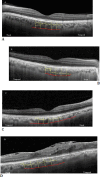Evaluation of Choroidal Thickness in Type 2 Diabetes Using Spectral-Domain Optical Coherence Tomography
- PMID: 40698112
- PMCID: PMC12277999
- DOI: 10.22336/rjo.2025.28
Evaluation of Choroidal Thickness in Type 2 Diabetes Using Spectral-Domain Optical Coherence Tomography
Abstract
Background and objectives: Microvascular changes induced by diabetes mellitus (DM) are the primary cause of diabetic retinopathy (DR) and choroidopathy. There is a lack of evidence linking diabetic retinopathy (DR) to changes in choroidal thickness (CT), so we designed this study to investigate this relationship. The choroidal thickness of DM patients, with or without DR, was compared to that of controls (subjects without diabetes) using spectral domain optical coherence tomography (SD-OCT).
Materials and methods: We recruited 132 participants for a prospective observational study. Choroidal thickness at five points: subfoveal and at 500 and 1000 µm, both temporally and nasally to the fovea, was measured. OCT measurements, insulin use, lipid profiles, age, gender, fundus examination, and glycaemic control were recorded. The inferential and descriptive statistics were applied.
Results: When compared to DM patients without DR, CT showed a trend toward lower values; however, only CT at 1000 μm temporal to the fovea (300.25 ± 65.37 μm in control group 1, 304.82 ± 76.71 μm in group 2, and 271.84 ± 65.07 μm in DR group 3) reached statistical significance (p = 0.05). Each diabetic subgroup did not differ in sub-foveal choroidal thickness (SFCT) (p = 0.586). Patients without DME (289.53 ± 63.86 μm) and those with DME (289.83 ± 100.99 μm) had comparable SFCTs (p = 0.992).
Discussion: When comparing diabetic patients with and without diabetic retinopathy to healthy controls, there are differences in CT (increased, decreased, or no change). The atrophy and dropout of the choriocapillaris in eyes with diabetic retinopathy may be the cause of the decrease in CT in DR patients that our study revealed.
Conclusion: DR patients showed a statistically significant decrease in CT at the 1000 μm temporal to fovea choroidal subregion compared to DM patients without DR. These results suggest that diabetes induces pathological changes in the choroid, resulting in retinopathy.
Keywords: CT = choroidal thickness; DM = Diabetes Mellitus; DME = diabetic macular edema; DR = Diabetic Retinopathy; NPDR = non-proliferative diabetic retinopathy; PDR = proliferative diabetic retinopathy; SD-OCT = Spectral domain optical coherence tomography; choroidal thickness; diabetes mellitus; diabetic retinopathy; macular edema; optical coherence tomography.
© 2025 The Authors.
Conflict of interest statement
The authors state no conflict of interest.
Figures
Similar articles
-
Optical coherence tomography (OCT) for detection of macular oedema in patients with diabetic retinopathy.Cochrane Database Syst Rev. 2015 Jan 7;1(1):CD008081. doi: 10.1002/14651858.CD008081.pub3. Cochrane Database Syst Rev. 2015. PMID: 25564068 Free PMC article.
-
Comparable choroidal thickness between treated eyes and untreated fellow-eyes in patients with unilateral neovascular AMD: a paired-eyes comparative study.Graefes Arch Clin Exp Ophthalmol. 2025 Jun;263(6):1543-1551. doi: 10.1007/s00417-025-06751-7. Epub 2025 Mar 8. Graefes Arch Clin Exp Ophthalmol. 2025. PMID: 40056163 Free PMC article.
-
Optical coherence tomography (OCT) for detection of macular oedema in patients with diabetic retinopathy.Cochrane Database Syst Rev. 2011 Jul 6;(7):CD008081. doi: 10.1002/14651858.CD008081.pub2. Cochrane Database Syst Rev. 2011. Update in: Cochrane Database Syst Rev. 2015 Jan 07;1:CD008081. doi: 10.1002/14651858.CD008081.pub3. PMID: 21735421 Updated.
-
Fenofibrate for diabetic retinopathy.Cochrane Database Syst Rev. 2023 Jun 13;6(6):CD013318. doi: 10.1002/14651858.CD013318.pub2. Cochrane Database Syst Rev. 2023. PMID: 37310870 Free PMC article.
-
Assessing the Role of Statins as an Adjunctive Anti-VEGF Therapy for Clinically Significant Macular Edema (CSME) in Type 2 Diabetes Mellitus.Rom J Ophthalmol. 2025 Apr-Jun;69(2):219-227. doi: 10.22336/rjo.2025.35. Rom J Ophthalmol. 2025. PMID: 40698099 Free PMC article. Clinical Trial.
References
-
- Williams R, Airey M, Baxter H, Forrester J, Kennedy-Martin T, Girach A. Epidemiology of diabetic retinopathy and macular oedema: a systematic review. Eye (Lond) 2004;18:963–983. - PubMed
-
- Brown MM, Brown GC, Sharma S, Shah G. Utility values and diabetic retinopathy. Am J Ophthalmol. 1999;128:324–330. - PubMed
-
- Javitt JC, Aiello LP, Chiang Y, Ferris FL, Canner JK, Greenfield S. Preventive eye care in people with diabetes is cost-saving to the federal government. Implications for health-care reform. Diabetes Care. 1994;17:909–917. - PubMed
-
- Javitt JC, Aiello LP. Cost-effectiveness of detecting and treating diabetic retinopathy. Ann Intern Med. 1996;124:164–169. - PubMed
-
- Cao J, McLeod S, Merges CA, et al. Choriocapillaris degeneration and related pathologic changes in human diabetic eyes. Arch Ophthalmol. 1998;116:589–97. - PubMed
Publication types
MeSH terms
LinkOut - more resources
Full Text Sources
Medical


